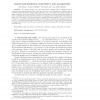Free Online Productivity Tools
i2Speak
i2Symbol
i2OCR
iTex2Img
iWeb2Print
iWeb2Shot
i2Type
iPdf2Split
iPdf2Merge
i2Bopomofo
i2Arabic
i2Style
i2Image
i2PDF
iLatex2Rtf
Sci2ools
107
Voted
WG
2001
Springer
2001
Springer
Graph Subcolorings: Complexity and Algorithms
In a graph coloring, each color class induces a disjoint union of isolated vertices. A graph subcoloring generalizes this concept, since here each color class induces a disjoint union of complete graphs. Erd╦Øos and, independently, Albertson et al., proved that every graph of maximum degree at most 3 has a 2-subcoloring. We point out that this fact is best possible with respect to degree constraints by showing that the problem of recognizing 2-subcolorable graphs with maximum degree 4 is NP-complete, even when restricted to triangle-free planar graphs. Moreover, in general, for ’¼üxed k, recognizing k-subcolorable graphs is NP-complete on graphs with maximum degree at most k2. In contrast, we show that, for arbitrary k, k-subcolorability can be decided in linear time on graphs with bounded treewidth and on graphs with bounded cliquewidth (including cographs as a speci’¼üc case). Key words. graph subcoloring, computational complexity, cograph, cliquewidth, treewidth AMS subject classi’¼...
Related Content
| Added | 30 Jul 2010 |
| Updated | 30 Jul 2010 |
| Type | Conference |
| Year | 2001 |
| Where | WG |
| Authors | Jirí Fiala, Klaus Jansen, Van Bang Le, Eike Seidel |
Comments (0)

